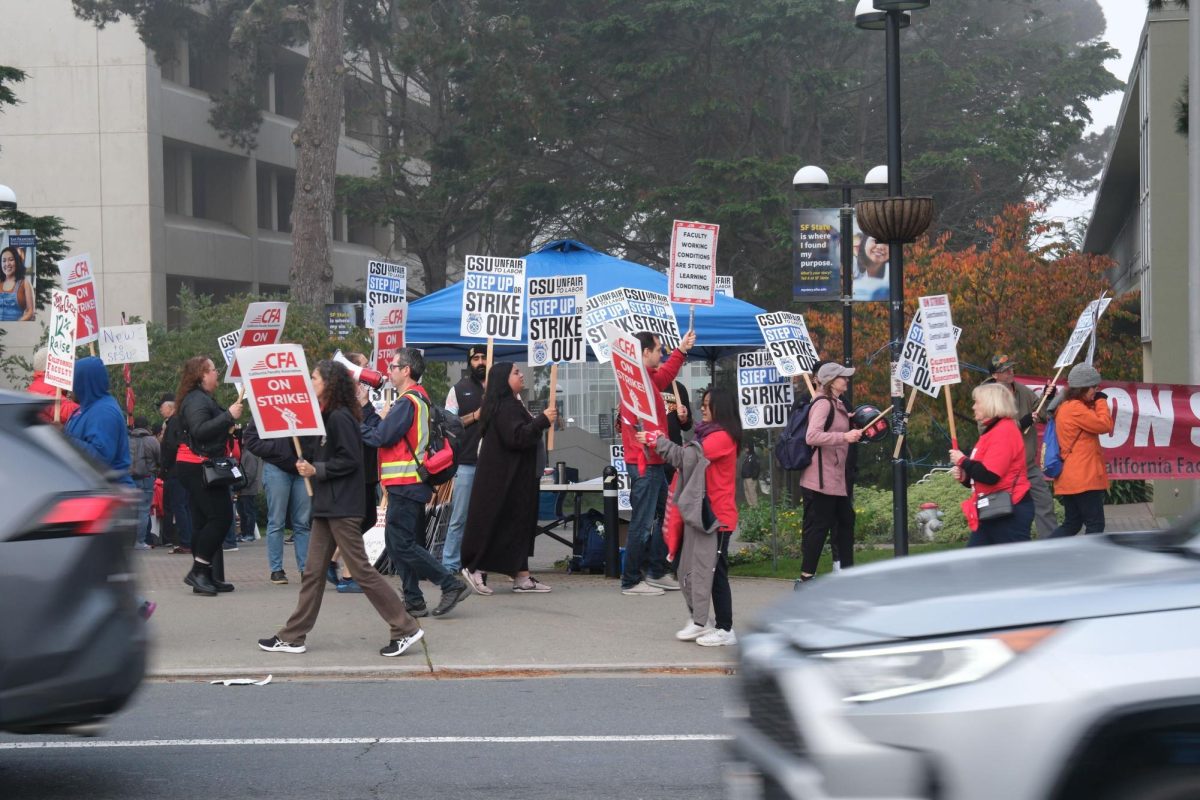Makeshift fans, hot air and adjusted curriculums have become the new norm for classes in the Humanities building during the warmer months of the year.

It’s been one year since the California Faculty Association (CFA) filed a grievance with the school following the efforts of a group of professors to address continuous temperatures above 80 degrees in their classrooms and offices. There has been no official response to the grievance, professors said.
English professor Larry Hanley, who is leading the push for accommodations, began researching classroom and office temperatures last year after colleagues shared their concerns about the heat feeling unbearable.
Hanley, who was a department representative for CFA at the time, distributed digital thermometers during the 2018-2019 school year to 20-30 faculty members and told them to record the readings in the Humanities building when a classroom felt uncomfortably hot.
“The readings were incredible,” Hanley said. “Some classrooms 84 degrees, some offices 93 degrees.”
The optimum range for workplace temperatures is 68-76 degrees, according to the Occupational Safety and Health Administration (OSHA).
English professor Jenny Lederer said she has taught many semesters in HUM 133, a notoriously stuffy auditorium with one door. She said she recorded consistent temperatures of 85-90 degrees September to November last year.
“For student learning, it’s a nightmare,” Lederer said. “I was teaching a 2 o’clock class, you can imagine students are already tired in the afternoon … I can remember days where students are fanning themselves, they’re sweating, they’re falling asleep. It’s just really quite miserable.”
“I’m not actually aware of specific cases where people have had their learning impacted,” Andrew Harris, Dean of the College of Liberal and Creative Arts (LCA) said. “That doesn’t mean it’s not happening, it’s just that that’s not something that’s come to my attention.”
One of Lederer’s students, senior Cheri Stryker, has multiple sclerosis (MS), a disease that affects the brain and nervous system. Stryker repeatedly missed class because the heat in the classroom aggravated her symptoms, and can cause “total body dysfunction,” she said.
“When I overheat — well the most recent experience was overwhelming vertigo,” Stryker said. “When I had to walk out of class and basically get down on the floor where it’s cooler.”
Stryker said she would like to see an AC system that keeps classroom temperatures at a consistently cool temperature.
“Of course I’m going to excuse the student’s absences, but that’s not a fair, equitable solution,” Lederer said, “Because you can’t have a DPRC (Disability Programs and Resource Center) student missing out on their learning.”
Because of her condition, Stryker said she can only take two to three classes per semester and doesn’t have spare energy to deal with administrators or facilities staff.
One creative writing professor fainted due to heat during a class in the 2018-19 school year and needed an ambulance, multiple professors said. English professor Mary Soliday said she is concerned for the wellbeing of untenured faculty who don’t feel safe voicing their experiences because they aren’t guaranteed continued employment, like the professor who fainted.
“As far as I know they can’t fire me for talking,” Soliday said. “But lecturers and assistant professors are not protected. So they complain all the time, but they don’t complain to supervisors because they’re afraid. And I hear so many stories of [faculty] who really struggle in these rooms, some of them have disabilities.”
After she and her students felt unwell in a hot classroom, Soliday sent an email to Harris in January 2018 detailing her classroom’s conditions, and asking for accommodations. After not receiving a solution or reassigned location, Soliday said she began recording the temperatures in various Humanities building classrooms for about a year.
“These rooms on the Tapia side were often between 80 and 90 degrees on any day where it was about 70 degrees outside,” Soliday said. “There were also many rooms on the atrium side, on all five floors, that were above [OSHA] standards.”
Soliday said she changed her writing class curriculum to not require online access or computer use, because the addition of computer heat to already-hot classrooms made the space too hot to teach in.
SF State administration and capital projects team plan to upgrade multiple buildings with air conditioning as part of future plans, professors said, but have not provided enough immediate solutions.
Harris said LCA forwards complaints to facilities and capital planning offices, as the college does not have the resources to make infrastructural changes to buildings. The university has requested funding from the chancellor’s office for a building-wide temperature control project, a multimillion dollar project, Harris said.
“The university has a variety of maintenance issues and these are old buildings and they need our help,” Harris said. “And I’m confident that our president will be successful with the chancellor’s office in securing that kind of support.”
Updates are necessary, considering that the average temperature of the Earth has increased since many of the buildings on campus were constructed, Lederer said. Research by scientific institutions around the world say the Earth is only getting warmer, and climate change has reached an almost irreversible point, according to a 2018 United Nations climate change report.
“We’re a university, which means we accept these scientific realities,” Hanley said, “And we need to adjust to it. And I don’t see the university doing that at all.”
Professors and students said they would like to see portable AC units installed in classrooms that have a tendency to get hot, as well as an AC system as part of a long term solutions. Some classrooms have fans following repeated complaints, but the noise is disruptive to instruction, professors and students said.
“I would be horrified if that student I have with MS passed out,” Lederer said. “I would feel kind of personally responsible, even if I don’t have control over the building temperature. So I felt an obligation to continuously complain about it.”











